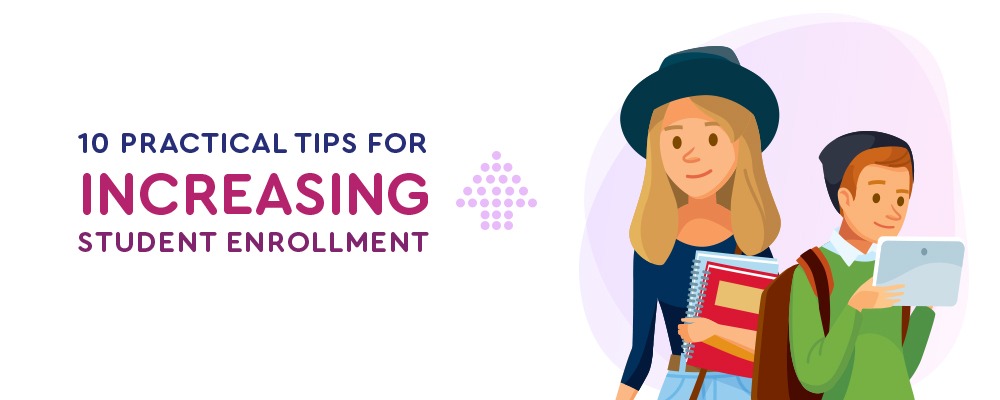There’s one thing that every admission manager dreads – not meeting their yearly student enrollment targets. Only 36% were able to meet them as on 1st May, according to Inside Higher Ed’s 2022 survey.
This makes it essential for enrollment teams to identify and apply strategies that help them push through their yearly targets. Here’s a list of 10 practical student enrollment strategies, you can apply to meet improve enrollments.
TL; DR, you can browse the infographic for an overview of the tips that help you increase student enrollments. 😊
10 Practical Student Enrollment Strategies for College Admissions Teams
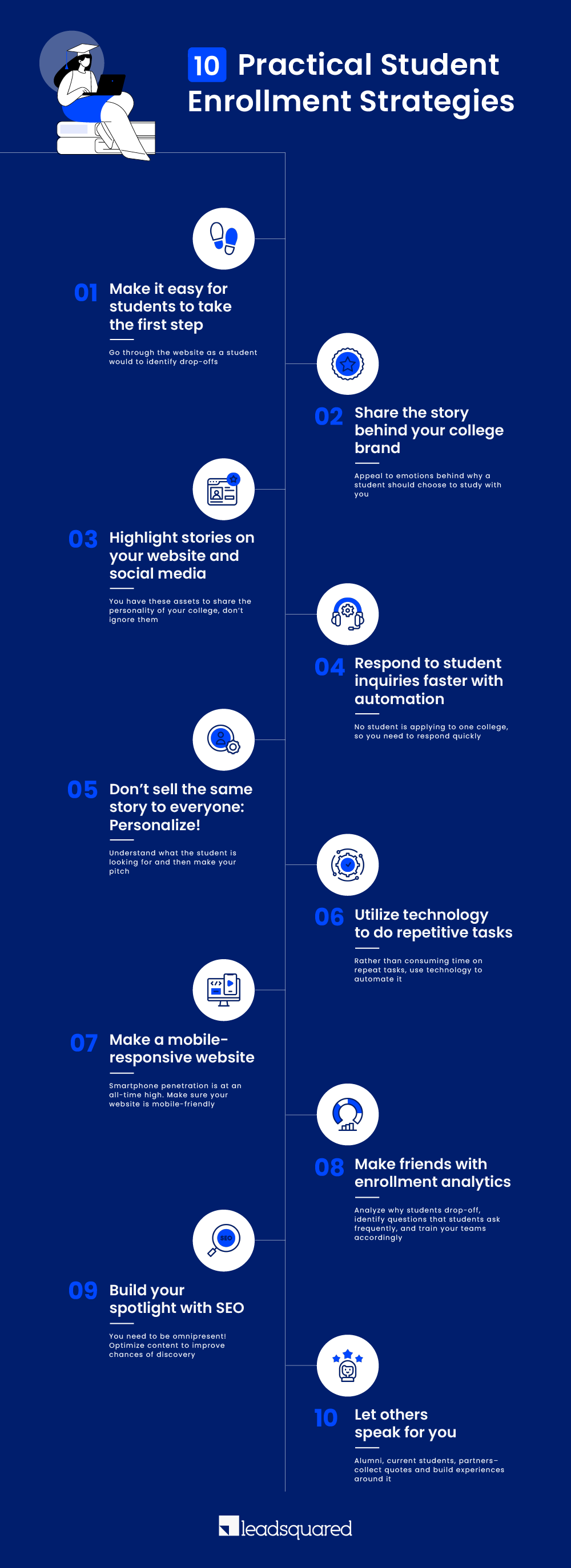
1. Make it easy for students to take the first step
It is important for students to discover you, but it is equally important to make it easy for them to reach out to you. Right from the time they land on your website, make sure you have simplified the path to apply for a course or to discover additional information.
You need to talk to students, analyze the drop-offs, understand what motivates them to apply, and course correct wherever necessary.
It could be as simple as using shorter forms to capture intent (name, email, course interested in) – with this information, your counselor will know how to take the conversation forward. And if you have course specific forms, then you just need two fields to start the conversation.
You could also use text prompts and explainer videos to help students fill application forms that are more detailed.
This exercise will help you build a better understanding of your student personas. You can use this information to improve your content, ad copies, and admission pitches. The result? Prompt action. The students that choose you will have clarity on the value you provide, and even recommend you to their friends and family to boost your enrollment rates.
“Admissions should be an informative process, not one designed to push students into a decision. Establishing a connection with the prospective student and their family is an important part of the process, as it can help to ensure the student will have a positive experience.”
Christopher Salvaggio, Chief Business Officer, Northwest Lineman College
2. Share the story behind your college brand
Well, when you are introducing yourself to a prospective student, wouldn’t you want to put your best foot forward? You need to represent your college’s values and what it stands for.
This is why you need to focus on the story you want to tell students who want to choose you as their education partner. The story should be emotional, have multiple characters, and the hero–the opportunities you provide.
Here’s how our client, Unitek Learning, shared how their college is focussed on a student-centric approach and how it benefitted Alexis.
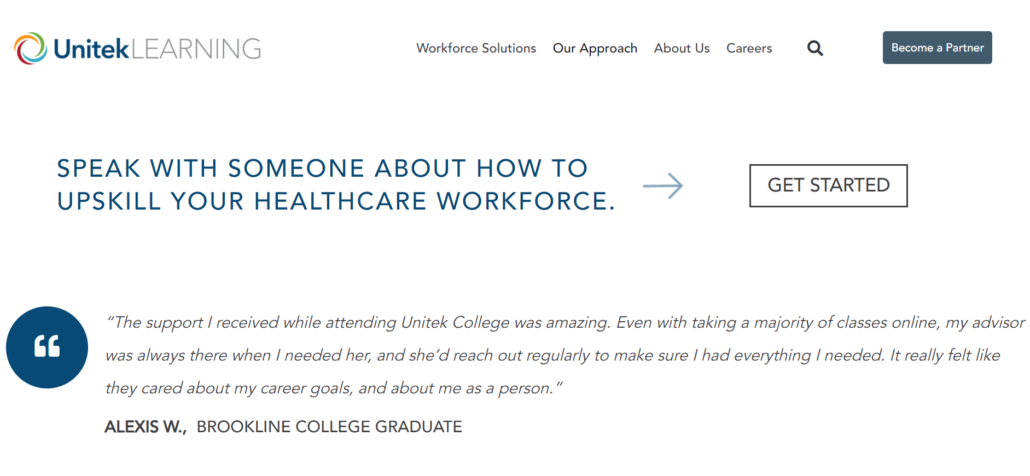
But for it to be believable, you need to identify your evangelists, your cheerleaders – the students that have studied with you, the parents that have gone through an admissions and financial cycle with you, and the companies/partners that trusted the value you provided through your graduates.
For example, here’s how Seed Global describes the top reasons for why student should study there
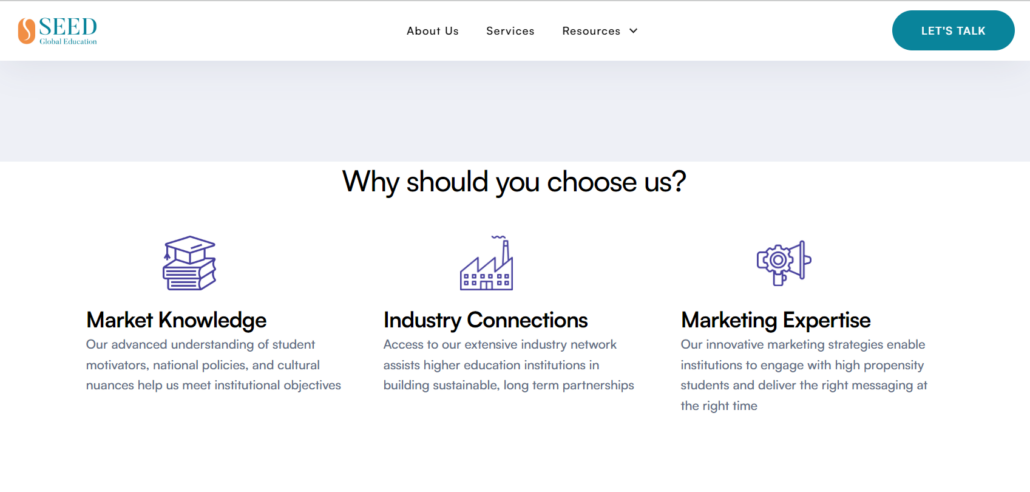
This helps the student as well as the parent make an informed decision by understanding the value proposition of the college they’re considering.
3. Highlight stories on your website and social media
After identifying your cheerleaders and collecting their stories, you need to publicize it. And the best places to start: your website and social media. Through these properties, you will be able to create a personality of your institution.
Why is it important for others to tell your stories? To build trust. According to a report by Social Admissions, more than 50% of teens rely on social media to help them choose their dream university.
You can distribute these stories organically or via paid media (online and offline). You could run awareness and engagement campaigns on Facebook and YouTube to build visibility. Keep a watch on the budget you spend as well as the number of enquiries each campaign brings you. Keep running the best ones and turn off the rest.
Having stories of student ambassadors help the prospects coming on to your website identify and connect with people like them. And this results in higher student engagement and enrollment rates for your college.
4. Respond to student enquiries faster with automation
Today’s generation wants instant answers to their queries. Education marketers who don’t adjust to this generation’s communication style may not be able to connect with them at all.
The earlier you make the emotional connection the better chance you have because once the applicants have decided that they like a particular school, it’s often difficult for them to backtrack. This is important in creating an emotional bridge between your school and the prospective student.
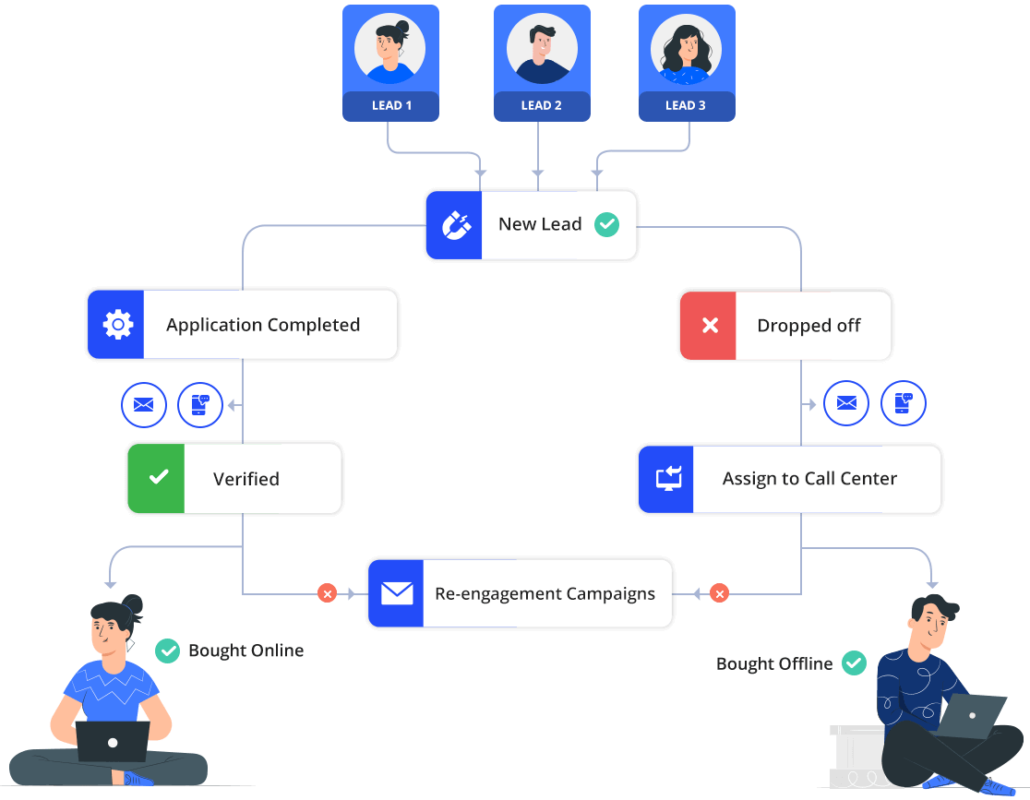
Most data experts say that the response time for your leads must be 5 minutes or less. This may seem nearly impossible but it’s possible.
With the help of a robust CRM like LeadSquared, you can set up custom admission workflow automations for that can send out multi-channel communications, distribute inquiries to the right counselor and reduce response time to under 5 minutes.
This is how Asher College improved their contact rates:
“LeadSquared’s lead distribution automation helped the admissions team increase speed-to-lead by 12 times. It helped them personalize communications throughout the student life cycle and track all the communications, offering continued rich student engagement from end to end. The contact rate went up by 13% and scheduled campus appointments improved by 5%.“
Kim Gasper, Corporate Director of Admissions, Asher College
5. Don’t sell the same story to everyone: Personalize!
Every student’s needs are different, so reiterating the same pitch will only make it harder for your enrollment teams to convince them. Students today like to access information at their fingertips. They can differentiate between the real deal and the BS.
You need to build a process that cues your teams to understand every student’s requirement. For example, Zac has visited your business and economics course pages. If you capture this information, you can utilize it to run a targeted ad for a business course with a specialization in economics on Facebook. Zac views this ad and receives an automated email about the future opportunities for Business graduates that you have sent out to your well-segmented list of prospects. He opens the email and wants to know more. Then your counselor gives him a call with a pointed pitch about the course.
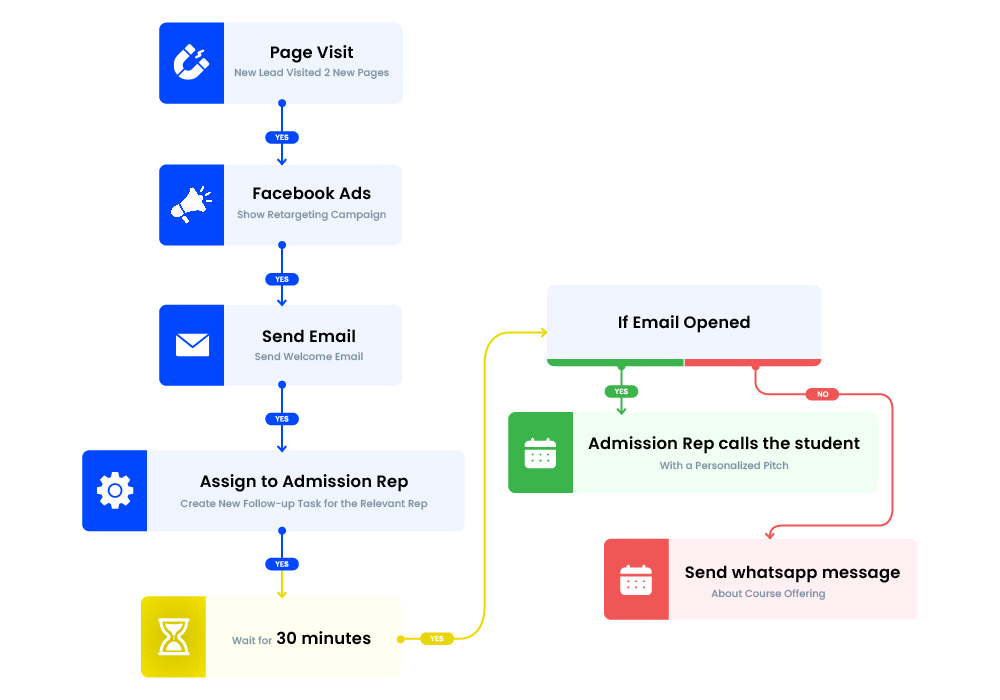
Do you think this will help him get convinced to start an application? 100%.
To empower your counselors with these personalization cues, you need a tool that can provide a 360-view of student activities, segment your audience, and enable targeted omnichannel communication with students. An end-to-end admissions platform like LeadSquared can help you do just that. To know more, get in touch with our team!
6. Utilize technology to do repetitive tasks
With the right technology, you can enable your teams to focus on building the emotional connect with the student rather than spend time on updating information.
The right student enrollment CRM can help you
- Manage and track student inquiries
- Update funnel stages to predict enrollment rates
- Provide qualitative insights to course correct
- Automate communication, reminders, and alerts
- Identify the people, channels, and processes that work for you
This results in the perfect trifecta – your counselors, admission managers, and channels are working in favor of meeting those enrollment targets.
You can implement chatbots, enrollment notifications, and autoresponders to serve your applicants better. Technology also helps enrollment teams widen the reach of their marketing and engagement efforts to hit goals. Identifying the right social media channels like YouTube, Facebook, Twitter, Instagram, Snapchat, Mobile Apps, etc. and combining them with the right tool and messaging can create magic.
7. Make a mobile-responsive website
Mobile device usage is on the rise, especially among the younger crowd. Imagine opening a poorly designed non-responsive website on your phone where you need to constantly zoom in and out. Forget applying for inquiry, anyone would just abandon the website simply out of frustration.
This responsiveness would allow them to apply from any device, at any time, without ruining the user experience. Having a mobile responsive application process and form will only bode well for your university and have a direct impact on your application rates.
Even the communication channels you choose should be mobile-compatible. For example, if you are writing them emails, make sure they have been optimized for mobile devices. Your website, contact information forms, student portal, etc. must be well-suited for mobile devices so that it doesn’t ruin the user experience.
8. Make friends with enrollment analytics
Enrollment marketing is not only about visibility. It has a bigger purpose to serve. It helps admissions managers understand their workings of their teamr, the counselors get to understand their students better, and the university is able to showcase the value it can provide once the student has chosen their path.
But to give clarity to each stakeholder, it is important to track and analyze every quantitative and qualitative enrollment KPI to make the process better.
These cannot be achieved without the help of a proper reporting mechanism. You need a student enrollment system with strong reporting and dashboard capabilities that you can refer to. Not only do you gather information about your prospects, but you’re also able to analyze the performance and the happenings of your admission reps, campuses, and courses.
Being an educational institute, your marketing budget might not allow you to spend recklessly. Therefore, mapping what works best for you and where you should put more or less money is necessary for better results.
You can check out this free webinar where Jenn Lyles, Enrollment Marketing Expert talks about the marketing hacks to save dollars and get fantastic results.
9. Build your spotlight with SEO
67% of prospects use search engines as the initial source of getting information about prospective schools. To increase your school’s visibility online (unless you are an ivy league), you need to invest in search engine optimization for your website and all content therein. Every single page needs to be designed with the intent to rank on search engines, and not just your homepage.
To begin, you need to perform keyword research. Identify a bucket of keywords or phrases that your school or college offers and that your candidates would be interested in. For example, while discovering schools, prospects usually search for terms such as “Best art programs” or “Business courses” instead of the name of the school.
Use this data to your advantage, so that when prospects begin to research for a course, your school appears on top. There is a myriad of tools that let you know what your target audience is searching for.
Here are the top 5 that can help you –
- Google Keyword Planner: Google’s free tool that provides valuable insights into keyword search volumes, competition levels, and suggested bid estimates, helping universities identify relevant keywords for their SEO strategies.
- SEMrush: A comprehensive SEO toolkit that offers keyword research capabilities, competitive analysis, and backlink tracking, to optimize websites, monitor rankings, and uncover new keyword opportunities.
- Moz Keyword Explorer: Moz’s powerful keyword research tool that provides in-depth keyword suggestions, search volume data, and keyword difficulty scores.
- Ahrefs: A versatile SEO toolset that includes a keyword explorer feature, allowing universities to discover valuable keyword ideas, analyze search volumes, and assess keyword difficulty.
- Ubersuggest: A user-friendly keyword research tool that offers keyword suggestions, search volume data, and competitive insights, providing universities with actionable SEO data to improve their website’s visibility.
10. Let others speak for you
As mentioned earlier, students would relate better with other students and their stories. You can identify a good mix of students–current, alumni, international students, students that did a semester abroad, and recent graduates, who can share their experiences and opportunities that your institution provided them.
[Also Read: How To Capitalize On Student Testimonials]
Real stories and culture keep the students engaged during their admissions lifecycle.
You can capitalize on student testimonials by including them in your marketing campaigns to connect with students. Check out this great example by Georgetown University that used this acceptance story to reach out to students.
Wrapping up
Enrolling students has never been an easy task. And it is only going to get tougher. If you want to stop losing sleep over your enrollment targets or your counselors are looking to improve their admissions game, I’d highly recommend you start applying these tips from today.
And you are not alone, you have technology to aid you. The right tool can help you automate communication, map student journeys, and show where you might be going wrong. In case, your university isn’t using an enrollment CRM or is looking to change its current clunky system–check out LeadSquared for Higher Education, it won’t disappoint!
FAQs
10 student enrollment strategies to improve your college admissions: –
1. Make it easy for students to take the first step
2. Share the story behind your college brand
3. Highlight stories on your website and social media
4. Respond to student inquiries faster with automation
5. Don’t sell the same story to everyone: Personalize!
6. Utilize technology to do repetitive tasks
7. Make a mobile-responsive website
8. Make friends with enrollment analytics
9. Build your spotlight with SEO
10. Let others speak for you
You need to be where your audience is–social media and Google search.
– Optimize your website content to rank for student inquiries,
– Share student stories on social media to build more awareness about the value you provide.
The right blend of search visibility, testimonials, and prompt response will help you attract more enrollments for your institution.
You need a robust enrollment management platform that can track incoming inquiries from various sources, automate multi-channel communication (email, text, chatbots), share in-depth funnel analytics, and share a 360-view of student activity with your counselors. This will help you manage and achieve your targets.
It is tough to respond to student inquiries manually and it may lead to many missed opportunities. Instead, you can set up automations to respond to student inquiries quickly. These automations could be an email response, assigning the right counselor, or setting up alerts for the team to take prompt action. Addressing student inquiries in under 1 hour will result in lesser student drop-offs, build funnel visibility, and help your team meet their enrollment targets.





